Balkinization
an unanticipated consequence of
Jack M. Balkin
Balkinization Symposiums: A Continuing List
E-mail:
Jack Balkin:
jackbalkin at yahoo.com
Bruce Ackerman
bruce.ackerman at yale.edu
Ian Ayres
ian.ayres at yale.edu
Corey Brettschneider
corey_brettschneider at brown.edu
Mary Dudziak
mary.l.dudziak at emory.edu
Joey Fishkin
joey.fishkin at gmail.com
Heather Gerken heather.gerken at yale.edu
Abbe Gluck abbe.gluck at yale.edu
Mark Graber
mgraber at law.umaryland.edu
Stephen Griffin
sgriffin at tulane.edu
Jonathan Hafetz
jonathan.hafetz at shu.edu
Jeremy Kessler
jkessler at law.columbia.edu
Andrew Koppelman
akoppelman at law.northwestern.edu
Marty Lederman
msl46 at law.georgetown.edu
Sanford Levinson
slevinson at law.utexas.edu
David Luban
david.luban at gmail.com
Gerard Magliocca
gmaglioc at iupui.edu
Jason Mazzone
mazzonej at illinois.edu
Linda McClain
lmcclain at bu.edu
John Mikhail
mikhail at law.georgetown.edu
Frank Pasquale
pasquale.frank at gmail.com
Nate Persily
npersily at gmail.com
Michael Stokes Paulsen
michaelstokespaulsen at gmail.com
Deborah Pearlstein
dpearlst at yu.edu
Rick Pildes
rick.pildes at nyu.edu
David Pozen
dpozen at law.columbia.edu
Richard Primus
raprimus at umich.edu
K. Sabeel Rahmansabeel.rahman at brooklaw.edu
Alice Ristroph
alice.ristroph at shu.edu
Neil Siegel
siegel at law.duke.edu
David Super
david.super at law.georgetown.edu
Brian Tamanaha
btamanaha at wulaw.wustl.edu
Nelson Tebbe
nelson.tebbe at brooklaw.edu
Mark Tushnet
mtushnet at law.harvard.edu
Adam Winkler
winkler at ucla.edu
Compendium of posts on Hobby Lobby and related cases
The Anti-Torture Memos: Balkinization Posts on Torture, Interrogation, Detention, War Powers, and OLC
The Anti-Torture Memos (arranged by topic)
Recent Posts
The Weapons of the Weak Before the Movement
Just A Few Blogs
ACS Blog
Alas, a Blog
Althouse
Arts and Letters Daily
Atrios (Eschaton)
Bill of Health
Buzzflash.com
Buzz Machine
Cato at Liberty
Juan Cole (Informed Comment)
Concurring Opinions
The Constitution in 2020
Corrente
Crooked Timber
Daily Howler
Daily Kos
Dana Boyd
Brad DeLong
Digby (Hullabaloo)
Discriminations
Daniel Drezner
Kevin Drum (Mother Jones)
Electrolite
En Banc
Eunomia (Daniel Larison)
Fafblog
Michael Froomkin (Discourse.net)
GovLab (Beth Noveck)
Rick Hasen (Election Law)
History News Network
How Appealing
Ignatz (Sam Heldman)
The Importance of (Ernie Miller)
Infolaw
Instapundit
International Economic Law and Policy Blog
IntLawGrrls
Jacob Levy
Jesus' General
Jurisdynamics
The Kitchen Cabinet
Mark Kleiman
Law Blog Central
Larry Lessig
Lawyers, Guns and Money
Liberal Oasis
Brian Leiter's Law School Reports
The Leiter Reports
Marginal Revolution
Megan McArdle
Memeorandum
Metafilter
Mirror of Justice
The New Republic
Newseum
No More Mister Nice Blog
Brendan Nyhan
Opinio Juris
Orcinus
The Originalism Blog
Pandagon
Passport (Foreign Policy)
Overcoming Bias
Political Animal (Washington Monthly)
Political Theory Daily Review
Political Wire (Taegan Goddard)
The Poor Man
Virginia Postrel
Prawfsblawg
Public Reason
Jonathan Rauch
Raw Story
Redstate
ReligiousLeftLaw.com
Reporters Committee For Freedom of the Press
Reproductive Rights Blog
Rothman's Roadmap to the Right of Publicity
SCOTUS Blog
Seeing the Forest
Clay Shirky
The Shifted Librarian
The Situationist
Larry Solum (Legal Theory)
Andrew Sullivan
Talking Points Memo
Talk Left
Tapped
Tbogg
TechPresident
The Paper Chase (Jurist)
Tom Paine
Tom Tomorrow (This Modern World)
Eve Tushnet
Uggabugga
University of Chicago Law School Faculty Blog
Unqualified Offerings
The Volokh Conspiracy
War and Piece (Laura Rozen)
Wampum
Oliver Willis
Wonkette
Written Description
Matthew Yglesias
Yin
Your Choice of Feeds
1. XML
powered by
2. Atom Feed
3. RSS 2.0
The Weapons of the Weak Before the Movement
Mark Graber
For the Balkinization symposium on Dylan C. Penningroth, Before the Movement: The Hidden History of Black Civil Rights (Liveright, 2023). The
rule of law provides the foundation for structuring elite domination and a
forge for fashioning the weapons of the weak.
The substance of law inevitably reflects the interests and values of the
lawmaking, law enforcing, and law interpreting class. One hardly needs to be a Marxist to
understand how the law of property, contract, and business associations privilege
those who have property to bestow by contract or protect by incorporation. The freedom of the press secures the rights
of those who have access to a press.
Elites that govern by law nevertheless provide a pathway by which the
less fortunate successfully make rights claims.
The Supreme Court vindicated Joseph Lochner’s right to work his
immigrant bakers more than ten hours a day, but the same justices would have
vindicated the right of those bakers to receive their contracted-for wages. A small incorporated black church in rural 1910
Alabama had the same limited liability as U.S. Steel. The
common law tort of seduction illustrates how law creates status hierarchies
while providing resources for the disadvantaged to assert rights against the
advantaged. Men committed the tort of
seduction by breaking off an engagement after having sexual relations with a
woman they promised to marry. Women, the
theory went, who were normally expected to resist the amorous advances of men who were not their husbands, could not be expected to and probably should not
be expected to resist, after their male partner proposed matrimony. The seduction tort was rooted in the separate
spheres ideology that dramatically limited female opportunity, in particular
the requirement that the woman bringing the lawsuit be a virgin before the
marriage proposal, Michael Grossberg’s Governing the Hearth nevertheless details
how women who acted consistently with nineteenth century gender roles, which included
the notion that women could not and probably should not strongly resist amorous
advances from their now fiancées, frequently won lawsuits against men, who did
not act consistently with their prescribed gender roles. Women who had no rights to be lawyers and
defend themselves against men who were shysters could collect against men who
were cads. Julie
Novkov provides another wonderful illustration of the weak weaponizing the law in
her study of miscegenation, Racial Union. Novkov documents how the Supreme Court of
Alabama at the turn of the nineteenth century was as inclined to toss as affirm
the convictions of couples charged with perpetrating an interracial
marriage. The justices in these cases
exhibited no sympathy for the liberal ideal that persons have a right to marry
the person of their choice. What evoked
judicial compassion were the rules of evidence.
Couples in an alleged mixed race marriage went free when they
demonstrated that the prosecution had made use of hearsay evidence to prove
that they were of different races. At a
time when birth records for poorer people were often difficult to find, the
legal antipathy to hearsay made prosecution for miscegenation difficult. White supremacy in Alabama yielded to the evidence
law. Before
the Movement: The Hidden History of Black Civil Rights is a classic study
of how African Americans used the law to assert rights at a time when the law
was openly committed or had a very thinly disguised commitment to white
supremacy. The legal commitment to rule
of law, Dylan Penningroth points out, provided benefits to enslaved
persons. If a master permitted an
enslaved person to have property, that enslaved person often could exercise quasi-property rights against
the rest of the world. More central to
the story, the post-Civil War Amendments provided black persons with the
same property rights, contract rights, and rights to incorporate as white
persons. Black persons may have had far
less property than white persons, but as a formal and often practical matter,
the sharecropper’s shack enjoyed the same legal protections as the rich
farmer’s mansion. A
review dedicated to the reviewer’s concerns with the book should at least pause
to acknowledge the exceptional book the author wrote. Before the Movement is a remarkable
combination of elbow grease, theoretical sophistication, and
story-telling. Professor Penningroth
provides the reader with the benefits of his years at obscure courthouses
looking for the records of the lawsuits African Americans brought during the
Reconstruction and Jim Crow Eras to vindicate their rights. He consistently reminds readers that ordinary
contract, property, and business association law are as much the civil rights
of black people as the anti-discrimination rights celebrated by the civil
rights movement, that former enslaved persons and their descendants were aware
of these rights, that former enslaved persons and their descendants exercised
these rights, and that these rights mattered in their lives both when asserted
directly and when structuring relationships in the shadow of the law. Professor Penningroth is a wonderful raconteur,
who brings to life the persons of color, some of whom were his ancestors, who legally
forged weapons of the weak. Most
important for purposes of this review, Before the Movement is empirically
and theoretically rich enough to provide valuable materials for those of us
with concerns that may be somewhat tangential to those that motivated the
author. Before the Movement explodes the argument that the regime of Jim Crow was just as bad as
the regime of slavery, that there is some racial rule of thermodynamics that
ensures that the quality of racism remains the same, even as white supremacy
takes different forms. Black people were
better off in the regime of Jim Crow than the regime of slavery because
formerly enslaved persons in the former regime had contract, property, and
other civil rights. Property law,
contract law, and business association law presented challenges to blacks who
sought to acquire property, but once acquired that property was subject to the
same legal protections as white property.
The law enabled African Americans to structure relations among
themselves as well as with white elites.
Penningroth is particularly interested in role the law of business
associations played in the development of black churches. Both in and out of church, formerly enslaved
persons knew their legal rights, exercised their legal rights, and bargained in
the shadow of those legal rights. The
notion of the ignorant tenant farmer was a myth, sometimes perpetuated by black
litigants and their lawyers, who knew that the law often excused persons from contract
obligations they did not fully understand. Professor
Penningroth often adopts an interest convergence theory of legal power in
American history. White law enforcers
and law interpreters sometimes protected the legal rights of black persons
because the benefits of the rule of law to white persons outweighed the
particular costs to particular white people in particular lawsuits. Elite interest in well defined rules of
evidence and a property law that clearly demarked who owned what was worth
preserving even when that meant a probable interracial couple was not legally
sanctioned or a white person could not steal land from a person of color. Ideology
also mattered. As Robert Gordon notes,
elites often believe that the rules they promulgate are fair and not crass
expressions of self-interest. A woman
should recover in a seduction suit, assuming all conditions met, because she
played her gender roles perfectly while the suitor who did the jilting was
nothing but a cad. A black person with a
valid property claim should be able to assert that claim in a court of law
because that is the point of property, a social institution that benefits all. Professor
Penningroth presents a largely uplifting story.
One central theme of Before the Movement is that the civil rights
protected by ordinary property, contract, and civil law ought to be given
similar status to the civil rights celebrated by the civil rights movement,
that the struggle for racial equality took place in contract, property and business
association law, as well as in constitutional law. Those civil rights may have even undermined
the Jim Crow regime. The law that
protected black property enabled persons of color to provide the resources
necessary to support the civil rights movement. The civil rights movement depended heavily on
local black lawyers, who made their living on property law cases that paid, not
suits to desegregate public schools which did not. Black people had faith in the law the
movement championed, because they had seen the law work for them in their daily
life. In a
different view, the civil rights of the property, contract, and corporate law at the turn of the twentieth century constituted
a different legal regime than the civil rights championed by the movement. The regime Penningroth documents was
committed to a formal legal equality that legitimated substantial inequalities
in practice. Race explained the division
of goods even as the law professed not to know the race of litigants. The civil rights movement sought to fashion a
legal order in which race did not explain the division of goods in part by employing law
that professed at time to know the race of litigants. Professor Penningroth’s call for a race
conscious contract and property pedagogy makes sense within the legal regime of
the civil rights movement, but not within a legal regime that purported to be
“colorblind.” The
stories Grossberg, Novkov, and Penningroth tell about how victims of status
hierarchies use legal systems cast doubt on E.P. Thompson’s famous claim that
the rule of law is an unmitigated good.
The rule of law prevents total domination by elite factions. Men do not always triumph in legal
controversies with women. Persons of
color sometimes make successful claims against white persons. These outcomes may reflect only the necessary
costs to elites of a legal system. A
legal system committed to white supremacy or patriarchy will generate outcomes
in particular instances that benefit those of the lower rungs of the status hierarchy
when the weak play their assigned cultural roles better than the strong. Persons win legal claims in an unjust legal
system by playing by unjust rules. Women
won seduction lawsuits by claiming to confirm fully to the inegalitarian gender
norms of the time. Mixed race couples
escaped punishment by claiming hearsay rather than challenging marriage norms
rooted in white supremacy. The
African-Americans Penningroth describes improved their individual lives by
respecting the rules of a system dedicated to achieving racial hierarchy
through formal legal equality. Their
behavior helped legitimate the system.
What better proof that contract, property and business association law
before the civil rights movement was legitimate than that the use of that law
by blacks to structure relationships among themselves and to claim legal rights
against whites not content to maintain white supremacy within the law.
Posted
9:30 AM
by Mark Graber [link]
Books by Balkinization Bloggers

Gerard N. Magliocca, The Actual Art of Governing: Justice Robert H. Jackson's Concurring Opinion in the Steel Seizure Case (Oxford University Press, 2025)

Linda C. McClain and Aziza Ahmed, The Routledge Companion to Gender and COVID-19 (Routledge, 2024)

David Pozen, The Constitution of the War on Drugs (Oxford University Press, 2024)

Jack M. Balkin, Memory and Authority: The Uses of History in Constitutional Interpretation (Yale University Press, 2024)
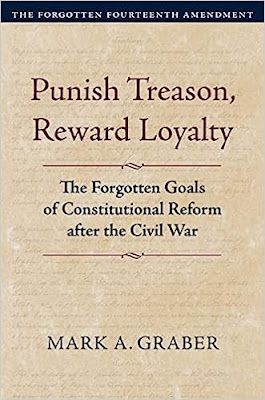
Mark A. Graber, Punish Treason, Reward Loyalty: The Forgotten Goals of Constitutional Reform after the Civil War (University of Kansas Press, 2023)
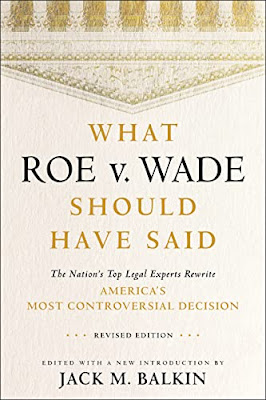
Jack M. Balkin, What Roe v. Wade Should Have Said: The Nation's Top Legal Experts Rewrite America's Most Controversial Decision - Revised Edition (NYU Press, 2023)

Andrew Koppelman, Burning Down the House: How Libertarian Philosophy Was Corrupted by Delusion and Greed (St. Martin’s Press, 2022)

Gerard N. Magliocca, Washington's Heir: The Life of Justice Bushrod Washington (Oxford University Press, 2022)
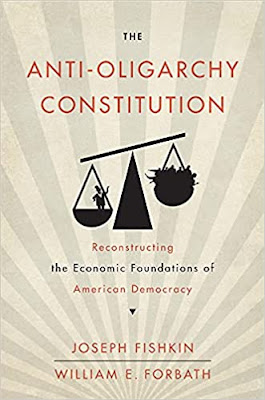
Joseph Fishkin and William E. Forbath, The Anti-Oligarchy Constitution: Reconstructing the Economic Foundations of American Democracy (Harvard University Press, 2022)

Mark Tushnet and Bojan Bugaric, Power to the People: Constitutionalism in the Age of Populism (Oxford University Press 2021).

Mark Philip Bradley and Mary L. Dudziak, eds., Making the Forever War: Marilyn B. Young on the Culture and Politics of American Militarism Culture and Politics in the Cold War and Beyond (University of Massachusetts Press, 2021).

Jack M. Balkin, What Obergefell v. Hodges Should Have Said: The Nation's Top Legal Experts Rewrite America's Same-Sex Marriage Decision (Yale University Press, 2020)

Frank Pasquale, New Laws of Robotics: Defending Human Expertise in the Age of AI (Belknap Press, 2020)

Jack M. Balkin, The Cycles of Constitutional Time (Oxford University Press, 2020)

Mark Tushnet, Taking Back the Constitution: Activist Judges and the Next Age of American Law (Yale University Press 2020).

Andrew Koppelman, Gay Rights vs. Religious Liberty?: The Unnecessary Conflict (Oxford University Press, 2020)

Ezekiel J Emanuel and Abbe R. Gluck, The Trillion Dollar Revolution: How the Affordable Care Act Transformed Politics, Law, and Health Care in America (PublicAffairs, 2020)

Linda C. McClain, Who's the Bigot?: Learning from Conflicts over Marriage and Civil Rights Law (Oxford University Press, 2020)
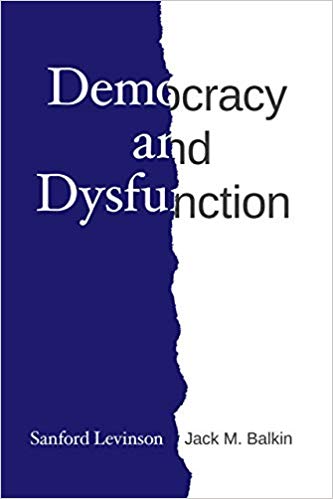
Sanford Levinson and Jack M. Balkin, Democracy and Dysfunction (University of Chicago Press, 2019)

Sanford Levinson, Written in Stone: Public Monuments in Changing Societies (Duke University Press 2018)

Mark A. Graber, Sanford Levinson, and Mark Tushnet, eds., Constitutional Democracy in Crisis? (Oxford University Press 2018)

Gerard Magliocca, The Heart of the Constitution: How the Bill of Rights became the Bill of Rights (Oxford University Press, 2018)

Cynthia Levinson and Sanford Levinson, Fault Lines in the Constitution: The Framers, Their Fights, and the Flaws that Affect Us Today (Peachtree Publishers, 2017)

Brian Z. Tamanaha, A Realistic Theory of Law (Cambridge University Press 2017)

Sanford Levinson, Nullification and Secession in Modern Constitutional Thought (University Press of Kansas 2016)

Sanford Levinson, An Argument Open to All: Reading The Federalist in the 21st Century (Yale University Press 2015)

Stephen M. Griffin, Broken Trust: Dysfunctional Government and Constitutional Reform (University Press of Kansas, 2015)

Frank Pasquale, The Black Box Society: The Secret Algorithms That Control Money and Information (Harvard University Press, 2015)

Bruce Ackerman, We the People, Volume 3: The Civil Rights Revolution (Harvard University Press, 2014)
Balkinization Symposium on We the People, Volume 3: The Civil Rights Revolution

Joseph Fishkin, Bottlenecks: A New Theory of Equal Opportunity (Oxford University Press, 2014)

Mark A. Graber, A New Introduction to American Constitutionalism (Oxford University Press, 2013)

John Mikhail, Elements of Moral Cognition: Rawls' Linguistic Analogy and the Cognitive Science of Moral and Legal Judgment (Cambridge University Press, 2013)

Gerard N. Magliocca, American Founding Son: John Bingham and the Invention of the Fourteenth Amendment (New York University Press, 2013)

Stephen M. Griffin, Long Wars and the Constitution (Harvard University Press, 2013)

Andrew Koppelman, The Tough Luck Constitution and the Assault on Health Care Reform (Oxford University Press, 2013)

James E. Fleming and Linda C. McClain, Ordered Liberty: Rights, Responsibilities, and Virtues (Harvard University Press, 2013)
Balkinization Symposium on Ordered Liberty: Rights, Responsibilities, and Virtues

Andrew Koppelman, Defending American Religious Neutrality (Harvard University Press, 2013)

Brian Z. Tamanaha, Failing Law Schools (University of Chicago Press, 2012)

Sanford Levinson, Framed: America's 51 Constitutions and the Crisis of Governance (Oxford University Press, 2012)

Linda C. McClain and Joanna L. Grossman, Gender Equality: Dimensions of Women's Equal Citizenship (Cambridge University Press, 2012)

Mary Dudziak, War Time: An Idea, Its History, Its Consequences (Oxford University Press, 2012)

Jack M. Balkin, Living Originalism (Harvard University Press, 2011)

Jason Mazzone, Copyfraud and Other Abuses of Intellectual Property Law (Stanford University Press, 2011)

Richard W. Garnett and Andrew Koppelman, First Amendment Stories, (Foundation Press 2011)

Jack M. Balkin, Constitutional Redemption: Political Faith in an Unjust World (Harvard University Press, 2011)

Gerard Magliocca, The Tragedy of William Jennings Bryan: Constitutional Law and the Politics of Backlash (Yale University Press, 2011)

Bernard Harcourt, The Illusion of Free Markets: Punishment and the Myth of Natural Order (Harvard University Press, 2010)

Bruce Ackerman, The Decline and Fall of the American Republic (Harvard University Press, 2010)
Balkinization Symposium on The Decline and Fall of the American Republic

Ian Ayres. Carrots and Sticks: Unlock the Power of Incentives to Get Things Done (Bantam Books, 2010)

Mark Tushnet, Why the Constitution Matters (Yale University Press 2010)
Ian Ayres and Barry Nalebuff: Lifecycle Investing: A New, Safe, and Audacious Way to Improve the Performance of Your Retirement Portfolio (Basic Books, 2010)
.jpg)
Jack M. Balkin, The Laws of Change: I Ching and the Philosophy of Life (2d Edition, Sybil Creek Press 2009)

Brian Z. Tamanaha, Beyond the Formalist-Realist Divide: The Role of Politics in Judging (Princeton University Press 2009)
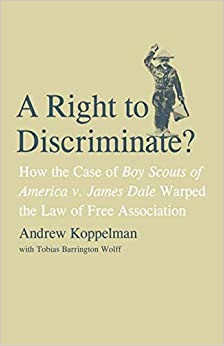
Andrew Koppelman and Tobias Barrington Wolff, A Right to Discriminate?: How the Case of Boy Scouts of America v. James Dale Warped the Law of Free Association (Yale University Press 2009)

Jack M. Balkin and Reva B. Siegel, The Constitution in 2020 (Oxford University Press 2009)
Heather K. Gerken, The Democracy Index: Why Our Election System Is Failing and How to Fix It (Princeton University Press 2009)

Mary Dudziak, Exporting American Dreams: Thurgood Marshall's African Journey (Oxford University Press 2008)

David Luban, Legal Ethics and Human Dignity (Cambridge Univ. Press 2007)

Ian Ayres, Super Crunchers: Why Thinking-By-Numbers is the New Way to be Smart (Bantam 2007)

Jack M. Balkin, James Grimmelmann, Eddan Katz, Nimrod Kozlovski, Shlomit Wagman and Tal Zarsky, eds., Cybercrime: Digital Cops in a Networked Environment (N.Y.U. Press 2007)

Jack M. Balkin and Beth Simone Noveck, The State of Play: Law, Games, and Virtual Worlds (N.Y.U. Press 2006)

Andrew Koppelman, Same Sex, Different States: When Same-Sex Marriages Cross State Lines (Yale University Press 2006)
Brian Tamanaha, Law as a Means to an End (Cambridge University Press 2006)
Sanford Levinson, Our Undemocratic Constitution (Oxford University Press 2006)
Mark Graber, Dred Scott and the Problem of Constitutional Evil (Cambridge University Press 2006)
Jack M. Balkin, ed., What Roe v. Wade Should Have Said (N.Y.U. Press 2005)
Sanford Levinson, ed., Torture: A Collection (Oxford University Press 2004)
Balkin.com homepage
Bibliography
Conlaw.net
Cultural Software
Writings
Opeds
The Information Society Project
BrownvBoard.com
Useful Links
Syllabi and Exams